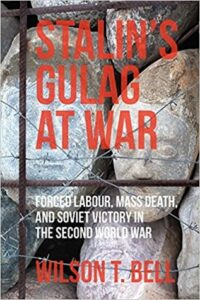In terms of academic accomplishments and milestones, 2019 was an exciting year, including for the “44 Lenin Avenue” project. Here are some of the highlights:

- My book, Stalin’s Gulag at War, came out in December 2018, but has a 2019 imprint, and I think of it as my first, big career-related news of the year. There have been a few reviews on Goodreads, and likely academic reviews will be coming soon. Like any first-book academic, I’m nervous to see what people have to say about it! It was fun to see it in the “wild,” so to speak, at Chapters in Halifax (picture below).
- The publication of the book led to podcast discussions with the SRB Podcast and the “On War and Society” podcast. I just found out that the SRB interview was one of the ten most popular of 2019. There were so many great interviews on SRB in 2019, so I’m especially honoured that so many people chose to listen to me.
- I gave public lectures or conference presentations on my research (either Gulag or the “44 Lenin Ave” project) at the Laurier Centre for Military, Strategic, and Disarmament Studies in Waterloo, Ontario; at the Stokes Colloquium Series at Dalhousie University in Halifax, Nova Scotia; and at the Association for Slavic, East European, and Eurasian Studies Convention in San Francisco, California.

- I earned tenure, promotion to associate professor, and a sabbatical for the 2019-2020 academic year! The sabbatical has given me the time to delve more deeply into research for this project (and to resurrect this blog).
- I won a Visiting Scholar position at L’École des hautes études en sciences sociales in Paris, which I’ll take up in May 2020. This award is specifically for research and dissemination of the “44 Lenin Ave” project. I will be delivering four lectures over the course of the month.
- I was awarded a major national grant: a Social Sciences and Humanities Research Council of Canada Insight Development Grant, which should allow me to complete the “44 Lenin Avenue” project.
- A review essay of mine, “Solzhenitsyn’s Legacy: Studying the Gulag in 2019,” came out in Canadian Slavonic Papers, and I also briefly explored the present-day impact of Solzhenitsyn’s work in an essay for The Conversation: Canada in September. I wrote several other book reviews over the course of 2019, one of which (a review of Cynthia Ruder’s excellent book, Building Stalinism in the journal Revolutionary Russia) is already out (the others should appear in 2020!).
- An anthology chapter, for a multi-volume Cultural History of Slavery, was officially accepted, and should come out in 2020 or 2021. In this chapter, I explore comparative forced labour systems from 1900-45, and it is amazing how pervasive the use of forced labour remained during this period, despite the abolition of serfdom and slavery. All major political and socio-economic systems of the period resorted to forced labour in various forms.
- In terms of contributing to the academy, more broadly speaking, 2019 has also been an interesting year: I was part of a team developing a proposal for a new MA at Thompson Rivers University, which was an eye-opening experience, and I also served as a program reviewer for an undergraduate history program, which was (perhaps surprisingly) a lot of fun!
All in all, 2019 was a very good year, professionally, and I’m very much looking forward to 2020. Thanks for reading this blog!
 I purchased Vatlin’s book at the recent ASEEES convention in San Francisco, so it is fresh on my mind. Translated and edited by
I purchased Vatlin’s book at the recent ASEEES convention in San Francisco, so it is fresh on my mind. Translated and edited by